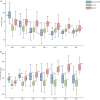Association of fluid balance trajectories with clinical outcomes in patients with septic shock: a prospective multicenter cohort study
- PMID: 34225807
- PMCID: PMC8258941
- DOI: 10.1186/s40779-021-00328-1
Association of fluid balance trajectories with clinical outcomes in patients with septic shock: a prospective multicenter cohort study
Abstract
Background: Septic shock has a high incidence and mortality rate in Intensive Care Units (ICUs). Earlier intravenous fluid resuscitation can significantly improve outcomes in septic patients but easily leads to fluid overload (FO), which is associated with poor clinical outcomes. A single point value of fluid cannot provide enough fluid information. The aim of this study was to investigate the impact of fluid balance (FB) latent trajectories on clinical outcomes in septic patients.
Methods: Patients were diagnosed with septic shock during the first 48 h, and sequential fluid data for the first 3 days of ICU admission were included. A group-based trajectory model (GBTM) which is designed to identify groups of individuals following similar developmental trajectories was used to identify latent subgroups of individuals following a similar progression of FB. The primary outcomes were hospital mortality, organ dysfunction, major adverse kidney events (MAKE) and severe respiratory adverse events (SRAE). We used multivariable Cox or logistic regression analysis to assess the association between FB trajectories and clinical outcomes.
Results: Nine hundred eighty-six patients met the inclusion criteria and were assigned to GBTM analysis, and three latent FB trajectories were detected. 64 (6.5%), 841 (85.3%), and 81 (8.2%) patients were identified to have decreased, low, and high FB, respectively. Compared with low FB, high FB was associated with increased hospital mortality [hazard ratio (HR) 1.63, 95% confidence interval (CI) 1.22-2.17], organ dysfunction [odds ratio (OR) 2.18, 95% CI 1.22-3.42], MAKE (OR 1.80, 95% CI 1.04-2.63) and SRAE (OR 2.33, 95% CI 1.46-3.71), and decreasing FB was significantly associated with decreased MAKE (OR 0.46, 95% CI 0.29-0.79) after adjustment for potential covariates.
Conclusion: Latent subgroups of septic patients followed a similar FB progression. These latent fluid trajectories were associated with clinical outcomes. The decreasing FB trajectory was associated with a decreased risk of hospital mortality and MAKE.
Keywords: Clinical outcomes; Fluid overload; Group-based trajectory model; Septic shock.
Conflict of interest statement
The authors declare that they have no competing interests.
Figures



References
-
- Singer M, Deutschman CS, Seymour CW, Shankar-Hari M, Annane D, Bauer M, Bellomo R, Bernard GR, Chiche JD, Coopersmith CM, Hotchkiss RS, Levy MM, Marshall JC, Martin GS, Opal SM, Rubenfeld GD, van der Poll T, Vincent JL, Angus DC. The third international consensus definitions for sepsis and septic shock (sepsis-3) JAMA. 2016;315(8):801–810. doi: 10.1001/jama.2016.0287. - DOI - PMC - PubMed
-
- Fleischmann C, Scherag A, Adhikari NKJ, Hartog CS, Tsaganos T, Schlattmann P, Angus DC, Reinhart K, International Forum of Acute Care Trialists Assessment of global incidence and mortality of hospital-treated sepsis. Current estimates and limitations. Am J Respir Crit Care Med. 2016;193(3):259–272. doi: 10.1164/rccm.201504-0781OC. - DOI - PubMed
-
- Xie J, Wang H, Kang Y, Zhou L, Liu Z, Qin B, Ma X, Cao X, Chen D, Lu W, Yao C, Yu K, Yao X, Shang H, Qiu H, Yang Y, CHinese Epidemiological Study of Sepsis (CHESS) Study Investigators The epidemiology of sepsis in Chinese ICUs: a national cross-sectional survey. Crit Care Med. 2020;48(3):e209–e218. doi: 10.1097/CCM.0000000000004155. - DOI - PubMed
-
- Cheng B, Xie G, Yao S, Wu X, Guo Q, Gu M, Fang Q, Xu Q, Wang D, Jin Y, Yuan SY, Wang J, du Z, Sun Y, Fang XM. Epidemiology of severe sepsis in critically ill surgical patients in ten university hospitals in China. Crit Care Med. 2007;35(11):2538–2546. doi: 10.1097/01.CCM.0000284492.30800.00. - DOI - PubMed
Publication types
MeSH terms
LinkOut - more resources
Full Text Sources
Medical
Miscellaneous

